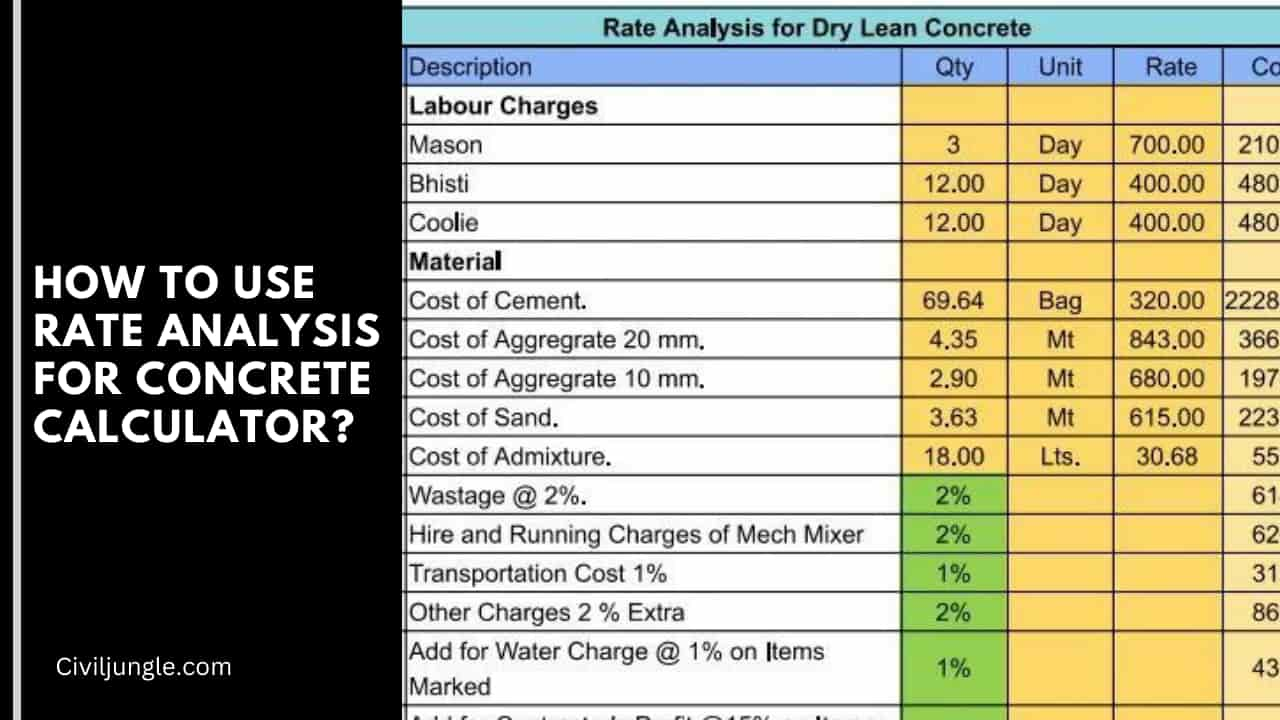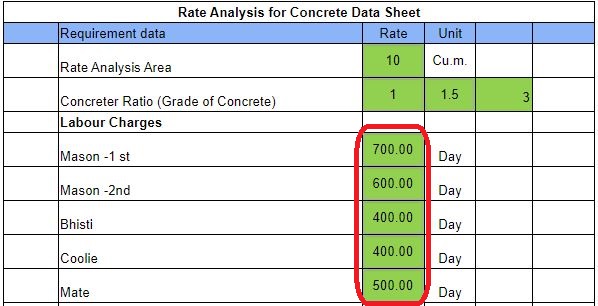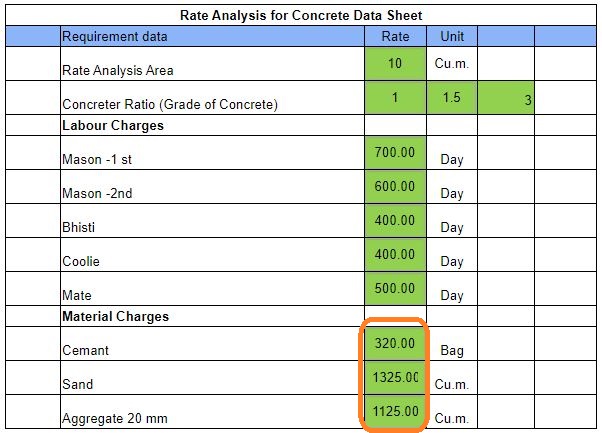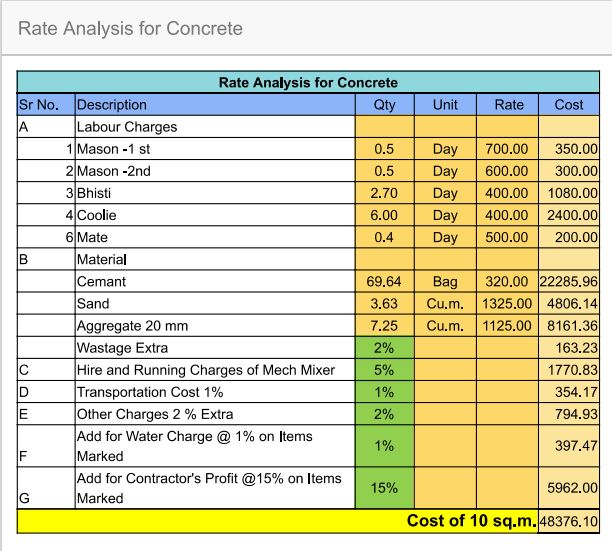What is Rate Analysis?
Important Point
The basis of arriving at a correct and reasonable rate per unit. Work or Supply for a particular item following its specification and detail survey of materials, labour, equipment, etc. as required for the unit work and their prevailing rates may be called as an analysis of rate.
How to Use Rate Analysis for Concrete Calculator
Step – 1. Select Area
First Enter your Rate analysis area in Cu.m. as per shown in the below picture.
Step – 2. Concrete Ratio (Grade of Concrete)
Enter your Concrete ratio as per shown in the below picture. (Cement and Sand ratio in Two cells Third cell count directly from sand*2 is Agreegate ratio of concrete)
Step – 3. Fill Labour Charges
Enter your labour charges rate like Mason 1st, Mason 2nd, Bhisti, Coolie and Mate as per shown in the below picture. ( Mason 1st, Mason 2nd, Bhisti, Coolie and Mate in different cells)
Step – 4. Fill Material Rate as Per Actual
Enter your material rate like cement, sand, and Aggregate as per shown in the below picture. ( Enter cement, sand, and Aggregate all are in different cells)
Step – 5. Final Report of Rate Analysis for Concrete
After completing the above steps you can check your Rate Analysis for Concrete Report in the second tab of Rate Analysis for Concrete.
Step – 6. Use Print Button for Print.
if you required to print your plastering work calculation you can use the print button option.
[the_ad id=”39531″]
Rate Analysis for Concrete Calculator
Material Calculation in Rate Analysis of Concrete
Like Cement, sand, aggregate, and reinforcement
Cement Calculation
Dry Cement volume = 1.33 convert Wet cement.(The concrete mortar dry volume of concrete decrease volume of dry cement mortar, so 1.33 time of dry mortar)
So, Cement calculation requirement of cement = 1 x 1.33 = 1.33 cu.m,
Herer calculation concrete ratio 1:1.5:3
The required amount of Cement quantity at concrete = 1.33 Cu.m. x (1/(1+1.5+3))
= 1.33 x 0.1819
= 0.242 cu.m. cement requirement
Cement in k.g. = volume x density cement
Cement in k.g. = 0.242 cu.m. x 1440 (1440 kg/m Density of cement for 50 k.g)
= 0.242 x 1440 = 425.646 kg of cement of bag requied ment of cement in k.g.
= 348.48 / 50 (one cemnent bag weight 50 k.g. only) = 6.96 bag
So, 10 cu.m. concrete requirement of cement = 6.96 bag x 10 cu.m. = 69.64 bag
Sand Calculation
- Required amount of Sand = 1.33 Cu.m. x (1.5/(1+1.5+3))
- =0.363 Cu.m. requierd of sand for 1 Cu.m.
- So,
- 10 cu.m. concrete requirement of sand = 0.363Cu.m x 10 cu.m. = 3.63 cu.m.
Also, rate: Instrumental Errors in Leveling | Type of Errors in Leveling
Aggregate Calculation
- The required amount of Aggregate
- = 1.33 Cu.m. x (3/(1+1.5+3))
- =0.725 Cu.m. required of sand for 1 Cu.m.
- So,
- So, 10 cu.m. concrete requirement of sand = 0.725 Cu.m x 10 cu.m. = 7.25 cu.m.
- Two types of aggregate like 20 mm & 10 mm size. this ratio 60 % of total aggregate 20mm size, 40 % of total aggregate 20mm size
- 20 mm aggregate = 7.25 cu.m.
Labour for Rate Analysis of Concrete
As per calculation of rate analysis in labour consumption per Cu.m. requirement as per our experience or CPWD book, this book public by Central Public Works Department, Government of India for easy calculation of the rate analysis, etc.
As CPWD Mate per cu.m. 0.27 of day bhisti, per cu.m 0.6 of day coolie, per cu.m. 0.05-day Mason -2nd, per cu.m. 0.05-day mason 1st, per cu.m. 0.04-day mate
Extra Work Calculation in Rate Analysis of concrete
Extra Changes in rate analysis as per below
Wastage Extra 2%
Hire and Running Charges of Mech Mixer 5%
Transportation Cost 1%
Other Charges 2 % Extra (Electrical, and site extra expense)
Add for Water Charge @ 1% on Items Marked
Add for Contractor’s Profit @15% on Items Marked
Like this post? Share it with your friends!
Suggested Read –
- Rate Analysis of Concrete
- Concrete Material Calculator | How to Work a Concrete Material Calculator
- Trapezoidal Footing Calculator | Trapezoidal Formula | Volume of Trapezoidal Footing
- Brick Masonry Calculator | Brick Masonry Calculator | Size of Bricks | Calculate Brick Work
- How to Use Rate Analysis of Brick Work Calculator| Rate Analysis of Brick Work Calculator
- Rate Analysis of Plastering Calculator | What is Rate analysis of Plaster | How to Use Calculator
- Plaster Calculator | How to Work Plaster Calculator | What Is Plaster Calculation | How to Plaster Calculation for Wall
- Steel Bar Calculation | Steel Bar Calculator | Reinforcement Weight | Reinforcement Weight Calculator | Rebar Weight Calculator
- House Construction Cost Calculator | How to Work With House Construction Cost Calculator. | What Is Construction Rate









Sir, how to Structural Design for plinth beam for residential building…. How to estimate dpc….. I request you sir, Pls give idea to solve….